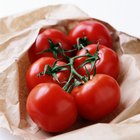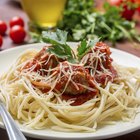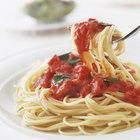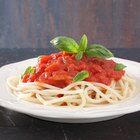
One of the keys to a successful pasta sauce is balance, just as you have to balance your daily duties as a mom. All of the ingredients and flavors should be in harmony, with no one dominating. In a tomato-based sauce, a common fault is that the tomatoes overwhelm the other ingredients. The result can be a sauce that is overly acidic, has a metallic taste or sometimes just lacks a rounded flavor. A well-balanced homemade sauce can use herbs and hidden vegetables to counteract those unpleasant flavors, while boosting nutrition for each pasta-loving child.
Lay a Broad Base
To make a balanced, mellow sauce, one of the most important steps is laying a broad base of flavor right at the beginning. Onions are vital, since their sweet and savory flavor is an important foil to the tomatoes. Dice at least one medium onion for every 1 1/2 quarts of sauce. Cook them gently in oil or butter until they are soft and lightly golden. You can add finely minced celery or shredded carrot at this stage if you wish. Add minced garlic at the end, stirring it just until it is aromatic. Don't let the garlic scorch.
Tame the Tomatoes
Toning down the tomatoes themselves is a second key to good sauce, especially if your recipe calls for tomato paste. Instead of adding the paste directly to the sauce, put it first in a small skillet with a tablespoon of olive oil. Saute the tomato paste gently, stirring with a silicon spatula, until it has browned and no longer smells acidic or metallic. Before adding diced fresh or canned tomatoes, pour off the juice. Strain out the seeds and simmer the juice separately until thickened, then add it back. Cook down the tomatoes to a pasty texture before adding the onions and other ingredients.
Adding Flavors
There are many flavors that can brighten a pasta sauce, providing a complement and a foil to the tomato flavor. Pasta sauce is also one of the best places to conceal nutritious vegetables from vegetable-averse kids. Shredded or finely-diced vegetables such as zucchini, eggplant, carrots or mushrooms add nutrition to the sauce, while also mellowing the tomato flavor. Fresh or dried herbs are also good choices, with oregano or basil being the most common. Thyme, tarragon, chives, parsley and rosemary also work well in tomato sauce. Some cooks also like theirs to have a hint of chili heat.
Finishing Touches
As your sauce cooks, taste it regularly and season it lightly with salt and pepper. Toward the end of of cooking, when all your major ingredients have been added, evaluate the flavors. If the tomatoes are still too assertive, you have several options. If their acidity is still prominent, add a small amount of sugar or extra salt. If on the other hand the sauce tastes bland and lifeless, add a few drops at a time of lemon juice or wine vinegar until it comes back to life. Counter a metallic flavor with extra herbs, a small amount of apple juice or white grape juice. Serve your sauce over whole-wheat pasta with a side salad with creamy dressing and a slice of toasted garlic bread.
Related Articles
Easy Tomato Basil Soup Recipe

How Can I Counteract the Sourness of a ...
Best Homemade Spaghetti Sauce Recipe

How to Fix Too Much Italian Seasoning ...

How to Tone Down Spiciness in BBQ Sauce

How to Keep Tomatoes Fresh

Is Marinara Sauce Good for You?

How to Make Plum Sauce

How Can I Make Curry Taste Less Bitter?
How to Make Homemade Spaghetti Sauce

How to Neutralize a Tomato Taste in ...

Calories in Pasta With Marinara Sauce

How to Reduce a Tomato Sauce

How to Know When a Tomato Goes Bad

How to Reduce Wine With Sugar to a Glaze

Effective Communication for Resolving ...

How to Cook Prime Rib Bones in a Slow ...

Tomato, Cooked or Raw, & Lycopene

How to Let Go of Someone You Really Love

How to Make Chipotle Sauce
References
- "On Food and Cooking: The Science and Lore of the Kitchen"; Harold S. McGee; 2004
- "Professional Cooking"; Wayne Gisslen; 2003
- Food Network; Basic Tomato Sauce; Mario Batali
Resources
Writer Bio
Fred Decker is a trained chef and prolific freelance writer. In previous careers, he sold insurance and mutual funds, and was a longtime retailer. He was educated at Memorial University of Newfoundland and the Northern Alberta Institute of Technology. His articles have appeared on numerous home and garden sites including GoneOutdoors, TheNest and eHow.
Photo Credits
Jupiterimages/Comstock/Getty Images